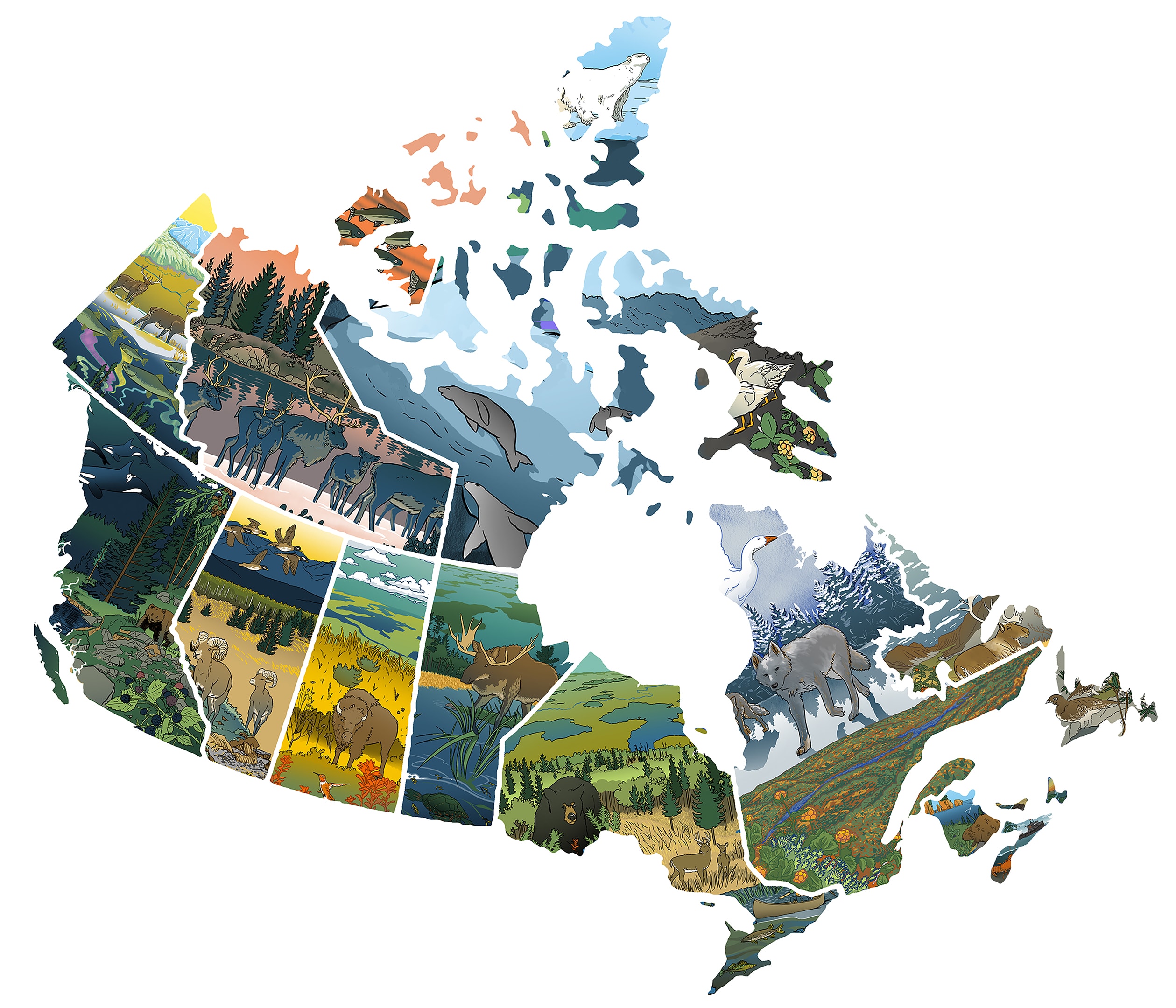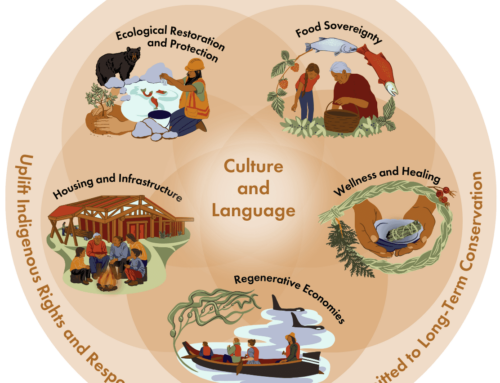A Review of Crown Legislation for Protected and Conserved Areas in Canada: A Guide for Indigenous Leadership
Prepared by: Victoria Kacer
With Contributions from: Leora Gansworth, Larry Innes, Kerry Lee Cormier, Kelsey Scarfone, Ian Attridge, and Matthew Green.
This work is licensed under a Creative Commons Attribution-NonCommercial-ShareAlike 4.0 International License
Publication Date: June 2023
Contents:
About This Guide
This guide provides an overview of Canadian federal, provincial, and territorial legislation for the creation of protected areas and parks. It is intended to inform Indigenous governments interested in advancing Indigenous Protected and Conserved Areas (IPCAs) through the Canadian legal system.
This guide is result of dialogues within the Conservation through Reconciliation Partnership IPCA Co-Learning Circle. It complements an earlier report produced by Larry Innes (OKT Law) and Georgia Lloyd-Smith (West Coast Environmental Law) which explored Indigenous laws in the context of conservation.
Indigenous governments can and have created IPCAs using own laws and authority without the formal recognition of Crown law. However, if an IPCA is not officially recognized by Canadian federal, provincial, or territorial law, it does not have protection within the Canadian legal system.
This lack of recognition may leave IPCAs vulnerable to unwanted development and activities permitted by public governments. Therefore, Indigenous governments may wish to negotiate with public governments to apply complimentary protection to the IPCA, such as a park or other form of protected or conserved area under federal, provincial, or territorial law.
This guide provides potential pathways for reaching agreements on establishing IPCAs with complimentary federal, provincial, or territorial protected or conserved area designations. It is important to note that this guide reflects the current state of land management laws and practices in Canada. It does not represent all possibilities, futures, or ways of visualizing and understanding land stewardship, or the scope of such agreements.
This guide is divided into fourteen sections: one for federal legislation, and one for each province and territory in Canada.
Each section:
- Identifies key protected area designations;
- Evaluates each designation according to the Indigenous Circle of Experts’ three guiding characteristics of IPCAs;
- Describes the limitations and benefits of each designation; and
- Outlines the process for creating each designation.
It also outlines relevant differences between designations in each region so that Indigenous governments can easily compare them and make informed decisions about what approach to pursue with regards to IPCAs.
Not all Indigenous governments and communities choose to pursue an approach that weaves Indigenous and Crown laws. This guide presents possible pathways to begin discussions regarding IPCAs within the Canadian legal system.
How to Use This Guide
To navigate this guide, click on the interactive map below to find an overview and in-depth analysis of your region’s protected areas designations in territorial or provincial law. Clicking on a section of the map will take you to a new page.
For information on federal designations, use the table of contents or scroll down to find Canada: Federal Legislation.
This guide also includes appendices that outline:
- Definitions
- Relevant International Union for Conservation of Nature’s (IUCN) Protected Area Categories
- Relevant United Nations Declaration on the Rights of Indigenous Peoples (UNDRIP) Provisions
- Relevant Kunming-Montréal Global Biodiversity Framework Targets
Please note that general references are hyperlinked within each section. For a full list of specific citations, refer to the PDF version of this guide.
Interactive Map
Click on the region you’d like to visit for more information on federal, provincial, or territorial legislation regarding parks and protected areas:
Key Takeaways
As it currently stands, no region in Canada has legislation that recognizes IPCAs as they are defined by the Indigenous Circle of Experts (ICE).
The three characteristics of IPCAs, as defined by ICE, are:
IPCAs are Indigenous-led
No regions have legislation that allows for the recognition of protected areas that are solely Indigenous-led. While there are several examples of co-management, the Crown is always involved in management to some degree.
IPCAs represent a long-term commitment to conservation
All protected areas discussed in this guide represent a long-term commitment to conservation. Some laws focus on the permanent protection of ecosystems.
IPCAs elevate Indigenous rights and responsibilities
Most regions in Canada include references to Indigenous rights and responsibilities in their protected areas legislation to some degree.
However, there are promising approaches to protected and conserved areas from across the country that work to elevate Indigenous rights and responsibilities. These include Conservancies in British Columbia, Indigenous Tribal Parks in Manitoba, the Protected Areas Act in Northwest Territories, and Aboriginal Protected Areas in Québec.
Promising Legislative Approaches
British Columbia: Conservancies
In British Columbia, Conservancies use a co-governance model where decision-making authority is shared between First Nations and the provincial government. Two examples are the Kitasoo Spirit Bear Conservancy, managed by Kitasoo/Xai’Xais Nation, and the Hakai Lúxvbálís Conservancy, managed by Heiltsuk Nation. While decision-making in Conservancies is shared, the Crown has ultimate decision-making authority.
Conservancies were proposed in response to First Nations concerns that Provincial Park designations did not support Indigenous land uses.
Conservancies are more flexible than Provincial Parks in the activities that they allow to preserve ceremonial and cultural values. For example, they allow Indigenous land uses as well as for First Nations to pursue small-scale, low-impact economic activities such as aquaculture and guided hiking.
Manitoba: Indigenous Traditional Use Parks
In Manitoba, Indigenous Traditional Use Parks can be established to protect land that is traditionally used by and significant to Indigenous Peoples. There is currently one Indigenous Traditional Use Park in Manitoba: Chitek Lake Anishinaabe Provincial Park.
This park was established as an Indigenous Traditional Use Park in 2014 based on a proposal from Skownan First Nation. Chitek Lake is currently a non-operational park, meaning it is legally protected but has no budget for management or operations
Northwest Territories: Protected Areas Act
In the Northwest Territories, the Protected Areas Act was created in collaboration with Indigenous governments and organizations, regulatory boards, stakeholders, and the public.
The Protected Areas Act requires collaborative management agreements between the territorial government and Indigenous governments.
These establishment agreements outline how the park will be managed, how disagreements are to be resolved, how to uphold Aboriginal and Treaty rights, and what activities will be allowed. Indigenous governments are effectively guaranteed a role in decisions about establishing and managing protected areas.
Québec – Aboriginal-led Protected Areas
Québec is the only jurisdiction to date that has included IPCAs in legislation in the form of Aboriginal Protected Areas (APAs). However, at the time of publication, no APAs have yet been created under this legislation.
Acknowledgements
The Domestic Law and Policy Stream of the Conservation through Reconciliation Partnership (CRP) would like to express gratitude to all the contributors for sharing their insights, expertise, and recommendations. This guide is a result of dialogues within the CRP’s IPCA Co-Learning Circle. It complements an earlier report produced by Larry Innes (OKT Law) and Georgia Lloyd-Smith (West Coast Environmental Law) which explored Indigenous laws in the context of conservation.
Thank you to Victoria Kacer, for taking on the role of lead author and doing the work that made this legislative scan possible. Thanks to Leora Gansworth, Larry Innes, Ian Attridge, and Matthew Green for their subject matter expertise in shaping and refining this guide.
Special thanks to Kerry Lee Cormier and Kelsey Scarfone their review, feedback, and recommendations on the first drafts.
The work of Ebany Carratt, Kristy Tomkinson, Allison Bishop, Elena McCulloch in editing, layout, formatting, logistical support, and web development has been invaluable in executing the vision of this project.
Thank you to Nicole Burton for designing the beautiful illustrations and to Jessica Lukawiecki for guiding the designs of cultural keystone species for this project.





